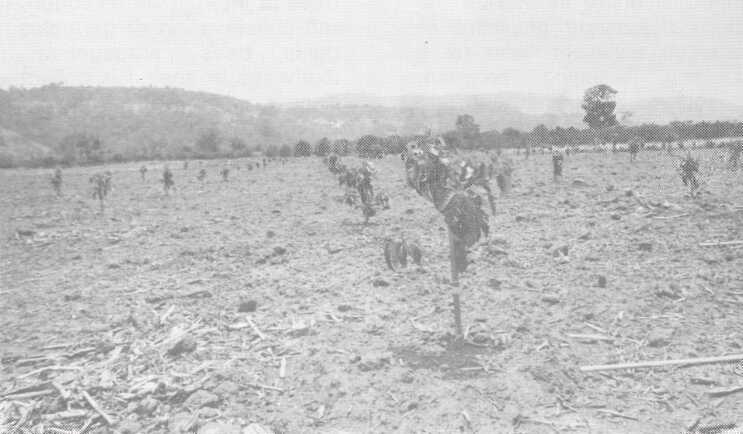Proc. of Second World
Avocado Congress 1992 pp. 543-544
A
Study of Avocado Germplasm Resources, 1988-1990. II. Findings from the Central
Part of Mexico
A. Ben-Ya'acov
Ministry of Agriculture, Agricultural Research Organization
Bet Dagan, P.O. Box 6, 50-150, Israel
L. López
López, Eulogio De La Cruz Torres, and Alejandro F. Barrientos Priego
CICTAMEX, Palacio Municipal,
Coatepec Harinas, Mexico, C.P. 51700, Mexico
Abstract.
Several explorations were made in the central area of Mexico, including the states
of México, Puebla, Querétaro, Morelos and Guanajuato, with the aim to locate
specimens of avocado (Persea americana Mill.) and related species of the genus
Persea with outstanding characteristics of vegetative growth, pest and disease
resistance, adaptation to unfavorable environmental conditions, good fruit
quality and phylogenetic importance for selection and breeding purposes. The
current status of this research is presented.
Mexico is a center of origin and dispersal of avocado
(Popenoe, 1935; Smith, 1966). Within its borders is a great diversity of types,
which constitutes a valuable germplasm resource that must be explored,
collected, preserved and evaluated. The great avocado genetic diversity in
Mexico, resulting from thousands of years of evolution is an excellent base for
a selection and breeding program. However, forest over-exploitation,
establishment of other crops and urban development are hastening the
elimination of Mexican race and other avocados, causing genetic erosion.
We initiated this study of the avocado genetic
resources with exploration and collection activities. We searched for
outstanding types, taking into account vegetative growth, fruit quality,
productivity and resistance to adverse conditions. We looked also for wild and
semi-wild species related to the Persea genus.
The area of exploration included the states of
México, Querétaro, Guanajuato, Puebla, Hidalgo, Tlaxcala, Morelos and
Aguascalientes.
Materials and Methods
To study avocado genetic resources, the first step is
to characterize agroecologically the areas that will be surveyed. Afterwards
the exploration activities begin by identifying trees of interest for
selection, breeding and conservation of germplasm. From these trees,
propagative material (budwood or seeds) is collected and a discussion of the
morphological characteristics is recorded.
Results
To date, twenty-two explorations have been made in
the states of México, Puebla, Guanajuato, Querétaro and Guerrero.
In the state of Mexico, the municipalities of
Tenancingo, Villa Guerrero, Malinalco, Temascaltepec, Coatepec Harinas,
Joquicingo, Almoloya de Alquisiras, Texcaltitlan, Valle de Bravo and Donato
Guerra were explored.
Among the most outstanding types found in this region
can be cited: "Aguacate Mantequilla"," Aguacate Dulce",
"Aguacate Tecomatudo" and "Aguacate Calabazudo".
In Puebla state, the surveyed areas were Tochimilco
and Atlixco. Propagative wood from the local selections "Principe
Negro", "Tochimilco", "Pellejo" and "Pahua"
was collected.
In Guanajuato state, a vast Mexican creole avocado
population was found at "Los Lorenzos", "El Paxhtle" and
"La Palma" localities. This region is important because of its thin
and lightly alkaline soils. Also in Guanajuato, in the municipality of Comonfort,
were located the high fruit quality selections "Tia Ines", "Don
Pedro" and "Huevo de Toro".
In the states of Querétaro and Guerrero just one
exploration has been carried out, so it is necessary to return to locate
outstanding types.
We have established two germplasm banks where we have
planted more than four hundred avocado trees selected from several parts of
Mexico.
One germplasm bank located at Coatepec Harinas has
avocado trees of the Mexican and Guatemalan races (Fig. 1). The West Indian
race
germplasm bank is at "El
Salitre", Ixtapan de la Sal, Mexico.
Discussion
In the central region of the Mexican Republic are
many local selections and outstanding trees, which must be surveyed and
collected immediately in view of the permanent danger of extinction caused by
forest fires, new crops and urban growth.
Due to the necessity of preserving avocado genetic
resources and to the high costs of maintenance of germplasm banks, there needs
to be an agreement among avocado producing countries to support this program to
benefit the world avocado industry.
Literature Cited
Popenoe,
W. 1935. Origin of the cultivated races of avocados. Calif. Avocado Assn. Yrbk.
pp. 184-194.
Smith,
C.E., Jr. 1966. Archaeological evidence for selection of avocados. Econ. Bot. 20:269-275.

Fig.
1. Mexican and Guatemalan avocado
germplasm bank at Coatepec Harinas, Mexico.